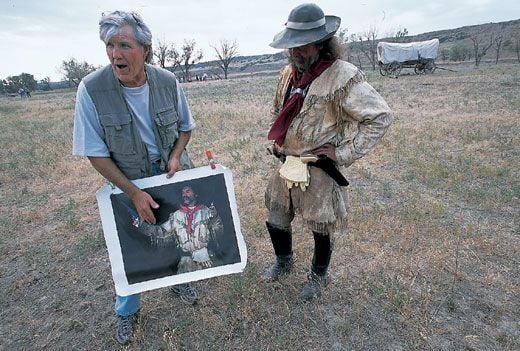Cowboys and Artists
Each summer models decked out in period dress give artists a picture of life in the Wild West
/https://tf-cmsv2-smithsonianmag-media.s3.amazonaws.com/filer/interest_cowboys.jpg)
The sun has yet to rise on Grant Shearer's 20,000-acre ranch near Wall, South Dakota, but already some 50 guests have gathered along the banks of the Cheyenne River. Loaded down with cameras and film, they wait for dawn—and for 60 or more cowboys and Indians to emerge from nearby tents, tepees, RVs and pickup trucks.
Suddenly, the sun breaks through, and a shout goes up: "The horses are coming! Get your cameras ready!" The photographers scurry toward the river's edge, as Shearer and four ranch hands drive 12 of his finest steeds through the camp, across the Cheyenne and back. "Run them again!" a woman shouts.
The characters decked out in Native American and Wild West regalia are models, and most of the photographers are oil painters, sculptors and watercolorists who specialize in scenes of the Old West. They're all here for the annual Artist Ride, a three-day-long, invitation-only event that re-creates Wild West tableaux for artists.
It's life imitating Frederic Remington, Albert Bierstadt and Charles M. Russell. It's also the largest event of its kind, attracting some of the genre's leading figures to a convivial affair that's as much reunion as tax deduction. On a sprawling campground, two white men pose as Lewis and Clark; a Lakota boy wields a bow and arrow; a Lakota woman cradles her two children. In the distance, Indians pursue a stagecoach; a trio of mountain men pause in a canoe in the middle of the river; a Korean-American portrays an 1860s "Chinaman" panning for gold at the river's edge. "There's just so much going on," says Rick Meoli, a St. Louis fine art photographer. "Why wouldn't you want to shoot it?"
And turn it into art. Karen Bonnie, of Del Norte, Colorado, credits 90 percent of her 2003 sales to the Ride. "If you know what you're doing," says fellow Colorado painter Craig Tennant, "you can come out of here with 30 paintings."
Rick Assunto, executive director of the Museum of Western Art in Kerrville, Texas, says that annual sales of western art total at least $50 million. (Last July, 281 western paintings and sculptures netted more than $18 million in a single day at the Coeur d'Alene Art Auction in Reno, Nevada.) "It's not just galleries offering western art now," says Richard Alterman of Santa Fe, New Mexico's Alterman Galleries, "the museums have jumped into the game."
The artist ride began in 1982 when Dale Lewis, then editor of Dakota West magazine in Fort Pierre, asked Grant Shearer's dad, Levon, to take some of his 40-plus historic wagons out into the Badlands so Lewis could photograph them. Artist Dan Deuter came along to take photographs as grist for future paintings. On a second ride a year later, Deuter and other invited artists spent most of their time stopping and setting up. He suggested they'd save time if they had a camp where they could create as many different scenes as they liked. Voilà. Deuter ran the ride until 1996, when he handed the reins over to its current director, Jim Hatzell.
Today artists pays $350 to attend, and models strut their stuff for artists' tips. (Hatzell, who says models can earn more than $800 during the three-day weekend, maintains a "Do Not Invite" list for chintzy tippers.) Artists pledge not to sell or even give away photographs, and Hatzell enforces other restrictions. "A bunch of oil painters wanted to come to this year's ride, and I had to tell them no," he says. "You can't have it be all in one medium, because then you’d have all these paintings using the same scenes and the same models, hitting the galleries at the same time too. You have to mix it up."
So do the models. John Sides, who portrays cowboys from the 1870s to today, says a good model can portray 15 different characters. Indeed, a peek inside his trailer reveals a plethora of canteens, cavalry dusters, leather jackets, kerchiefs and hats of all shapes and sizes: "It's like turning a page in a book, and you’re back in time."
Most of the artists rely on the models' own knowledge of historic detail—from the way they sit their McLellan saddles to the type of beads used on a war shirt to the gear favored by Buffalo Bill. "If a model puts a Sioux war shirt on top of Crow leggings," says Deuter, "that's how the artists will paint it." For that reason, Hatzell says, most models are Indians, park rangers, reenactors or ranchers who make it their business to know what they're doing.
But the Ride isn’t for everyone. Fred Fellows, director of Cowboy Artists of America (which sponsors a trail ride for members), was frustrated by his experience on an earlier Ride. "For all the film and work, it wasn't worth my time," he says. "An artist who lives by the camera dies by the camera. The color in film might be totally different from an image painted in real life."
Deuter counters that most artists use material from a variety of sources—photographs, artworks and nature. David Yorke, a former Disney animator turned painter, agrees. "It's like a painter's palette: the more colors you have, the more choices you have," he says. "You can’t get too much material."
For the Indian models in particular, the event helps preserve a heritage. "The way I look at it, my ancestors still exist, and the impact they made, their legacy, is still here," says Moses Brings Plenty, an actor who has appeared in such films as Pirates of the Caribbean. "And through their artwork these artists are carrying on what we do, what we teach them, to others."
"The West is dying," says Shearer. "If not dying, dwindling. It'd be a shame to see all this just go by the wayside."
